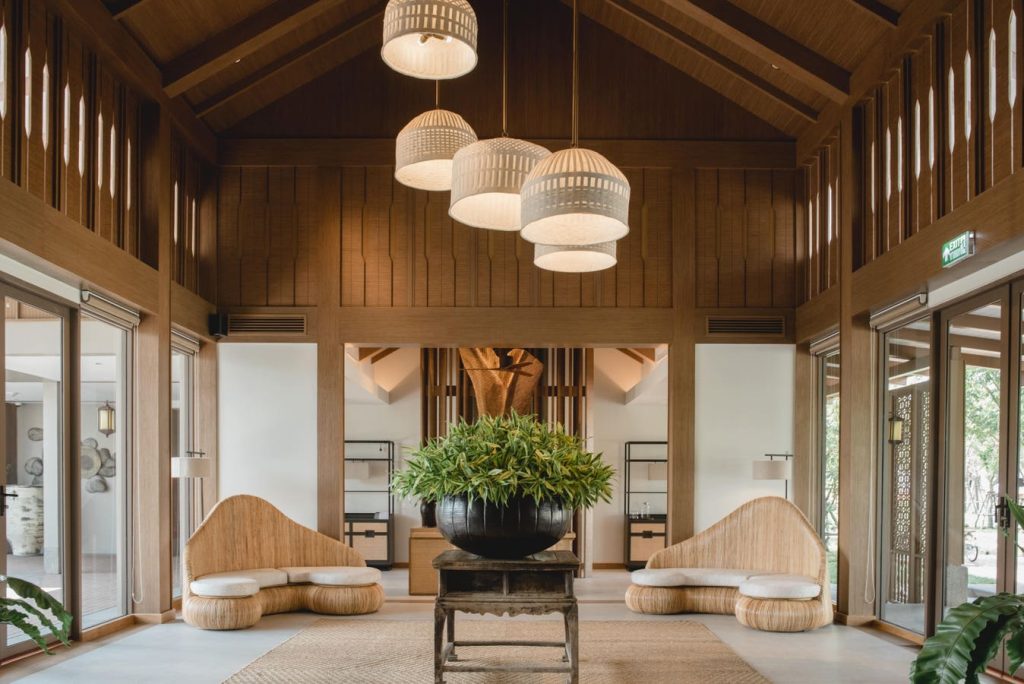Located in Bangkok’s “green lung”, Rakxa is one of Thailand’s best wellness centre
Courtesy of Rakxa
Health is wealth—this saying is especially true when you look at the exponential growth of the wellness industry. According to the Global Wellness Institute, the sector is currently valued at over USD$6 trillion and it’s projected to reach $9 trillion in 2028.
Today, the influence of the wellness industry is massive: it shapes how we eat, sleep, move and think. Over the last decade, there’s been a growing desire to integrate wellness into every aspect of life, down to our interiors. From hotels to homes and schools, more designers are applying tried-and-tested wellness principles into tangible spaces.
How do you actually define wellness design? Essentially it boils down to creating interior environments that improve health and well-being. This means crafting spaces that are inherently calming, connected to nature, and scaled for humans.
Rakxa is a masterclass in wellness design
Courtesy of Rakxa
This is something done particularly well at Rakxa—a leading integrative wellness center located in Bangkok’s green lung, Bang Kachao, that’s a masterclass of wellness design. We speak to Dr. Tal Friedman, Wellness Operations Director of Rakxa, on the thinking behind the holistic design and how we can replicate them in our personal spaces.
The wellness industry touches every part of life. As a brand, how does Raxka define wellness design and why is it important?
At Rakxa, wellness design is the intentional creation of environments that support physical, mental, and emotional wellbeing. It’s informed by both our Thai heritage and evidence-based principles of holistic healing, where the environment plays a central role in a person’s capacity to recover, rest, and thrive.
Rakxa’s overall design is derived from creating a powerful connection with nature
Courtesy of Rakxa
Nature is the foundation of our design philosophy. Drawing from traditional Thai wisdom, we recognize that balance and well-being are deeply connected to the natural world.
This is reflected in every aspect of our built environment, from the use of natural materials to landscaping (we planted over 4,000 native trees) that invites biodiversity and fresh air into the guest experience. Many of our spaces are designed to be open-air or to seamlessly blend indoor and outdoor areas—enhancing natural ventilation, light, and sensory connection to the environment.
To us, wellness design should create a sense of ease as well as inspire people to want to feel well. A good example is our wellness and longevity clinic, VitalLife, developed in collaboration with Bumrungrad International Hospital.
A sense of warmth is a key pillar of wellness design
Courtesy of Rakxa
The space is thoughtfully curated with local handicrafts like Thai kites and pottery, warm textures, and views over a private lagoon. It’s designed to feel serene rather than clinical, allowing guests to receive treatments like IV therapy in a space that feels nourishing and peaceful.
Wellness at Rakxa is also about redefining luxury. Not in the traditional sense, but in a way that’s barefoot, grounded, and deeply comforting. It’s a luxury where guests feel safe to slow down, tune in, and reconnect with nature, and with themselves.
Everyone needs a place to reset. Can you share three things that you considered when creating villas in Rakxa that we can apply into our spaces?
First, choose designs that support the body. Our villas were designed in collaboration with doctors and wellness specialists to support the body’s natural rhythms. From beds no higher than 70cm for ease of movement to blackout curtains that encourage healthy sleep, every detail is designed for the purpose of optimal rest. In your home, choose ergonomic furniture, reduce visual clutter, and use layered lighting to create a body-friendly environment.
A peek into a private garden villa at Rakxa
Courtesy of Rakxa
Secondly, prioritize natural materials. At the resort, we use hypoallergenic, organic materials, down to a customizable pillow menu and a soft palette of earth tones to help regulate the nervous system. At home, try to opt for breathable fabrics, toxin-free materials, and natural textures like linen, wood, and stone in calming shades such as clay, sand, and green.
Lastly, always ensure a strong connection to nature. Each villa at Rakxa includes its own botanical garden and reflexology path, encouraging guests to engage with nature through barefoot walks and mindful movement. In your space, introduce indoor plants and create moments to connect with nature—even a small balcony garden or daily walk can support your well-being.
The relaxing pool villa at Rakxa
Courtesy of Rakxa
Small things make a huge difference. Can you share simple touches that help ensure guests’ well-being?
We believe small, thoughtful details can significantly enhance well-being. For example, we place seasonal flowers in shallow water bowls—a traditional Thai practice to welcome good energy into the space—something really easy for anyone to replicate at home.
We also use local handicrafts, which add warmth and a human touch to the space, making it feel more personal and grounding. We pay close attention to furniture ergonomics, ensuring that bed height, seating angles, and materials reduce physical strain and support posture.
At home, simply adjusting the height of your chair or choosing a supportive cushion can improve comfort and relaxation.
The use of natural materials and textures help create a calming ambience
Courtesy of Rakxa
Lastly, urban environments are inherently stimulating. Wat are your suggestions to create a restorative space?
Rakxa is also located within a city, just across the river from Bangkok’s bustling center, so we understand the challenges of urban living. It is, however, still possible to create a restorative space at home.
Start by bringing in nature through indoor plants and natural textures. Maximize natural lighting during the day, and use muted tones to reduce sensory overload.
Keep spaces decluttered to ease the mind, and choose materials like wood, linen, or organic cotton that support cleaner air quality and comfort. With small, intentional changes, any urban space can become a place of calm and reset.
MORE FROM FORBES

